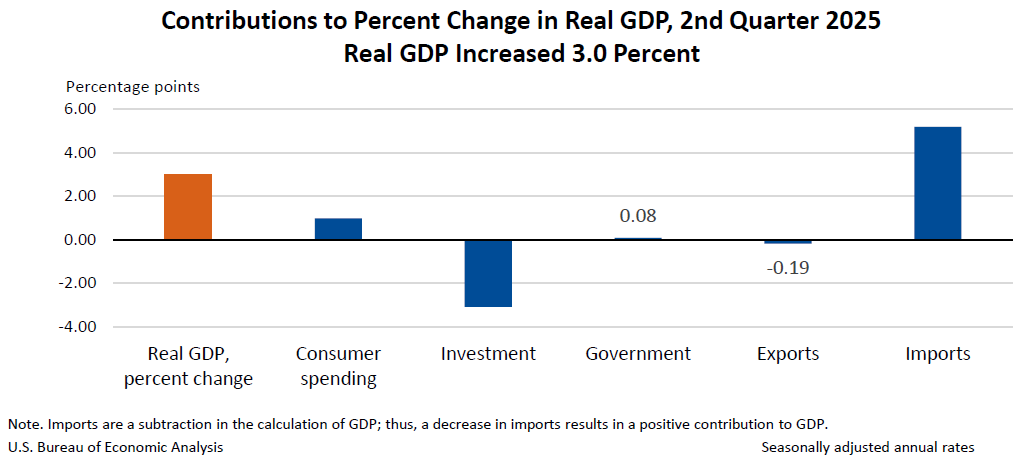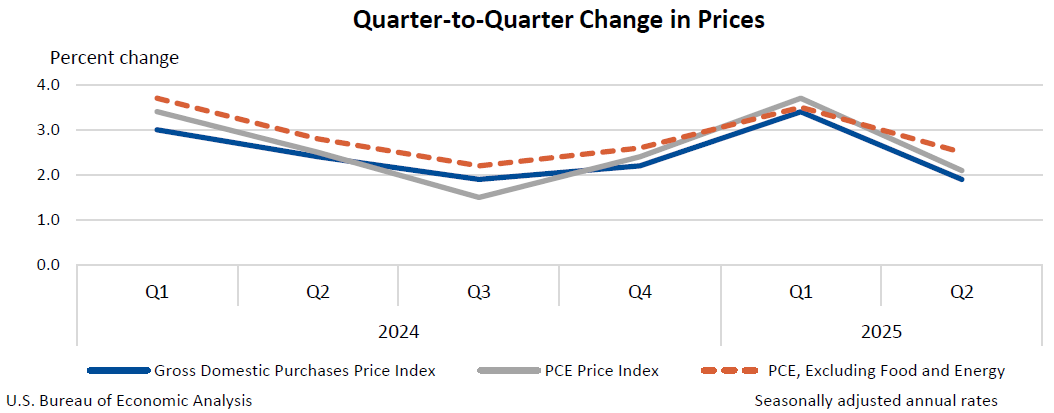News Release
Gross Domestic Product, 2nd Quarter 2025 (Advance Estimate)
Real gross domestic product (GDP) increased at an annual rate of 3.0 percent in the second quarter of 2025 (April, May, and June), according to the advance estimate released by the U.S. Bureau of Economic Analysis. In the first quarter, real GDP decreased 0.5 percent.
The increase in real GDP in the second quarter primarily reflected a decrease in imports, which are a subtraction in the calculation of GDP, and an increase in consumer spending. These movements were partly offset by decreases in investment and exports. For more information, refer to the "Technical Notes" below.
Compared to the first quarter, the upturn in real GDP in the second quarter primarily reflected a downturn in imports and an acceleration in consumer spending that were partly offset by a downturn in investment.
Real final sales to private domestic purchasers, the sum of consumer spending and gross private fixed investment, increased 1.2 percent in the second quarter, compared with an increase of 1.9 percent in the first quarter.
The price index for gross domestic purchases increased 1.9 percent in the second quarter, compared with an increase of 3.4 percent in the first quarter. The personal consumption expenditures (PCE) price index increased 2.1 percent, compared with an increase of 3.7 percent. Excluding food and energy prices, the PCE price index increased 2.5 percent, compared with an increase of 3.5 percent.
| Real GDP and Related Measures (Percent change from Q1 to Q2) | |
|---|---|
| Advance Estimate | |
| Real GDP | 3.0 |
| Current-dollar GDP | 5.0 |
| Real final sales to private domestic purchasers | 1.2 |
| Gross domestic purchases price index | 1.9 |
| PCE price index | 2.1 |
| PCE price index excluding food and energy | 2.5 |
BEA will begin releasing results from the 2025 annual update of the National Economic Accounts, which include the National Income and Product Accounts as well as the Industry Economic Accounts, on September 25, 2025. The update will present revised statistics for GDP, GDP by Industry, and GDI. For details, refer to Information on 2025 Annual Updates to the National, Industry, and State and Local Economic Accounts .
Next release: August 28, 2025, at 8:30 a.m. EDT
Gross Domestic Product (Second Estimate),
Corporate Profits (Preliminary Estimate),
2nd Quarter 2025
Technical Notes
Sources of change for real GDP
Real GDP increased at an annual rate of 3.0 percent (0.7 percent at a quarterly rate 1) in the second quarter, primarily reflecting a decrease in imports and an increase in consumer spending that were partly offset by decreases in investment and exports.
- Exports and imports primarily reflected Census Bureau-BEA U.S. International Trade in Goods and Services data as well as the Census Bureau's Advance Economic Indicators Report for June.
- Within imports, the decrease primarily reflected a decrease in goods, led by nondurable consumer goods, except food and automotive (mainly medicinal, dental, and pharmaceutical preparations, including vitamins).
- Within exports, the decrease primarily reflected a decrease in goods, led by automotive vehicles, engines, and parts.
- The increase in consumer spending reflected increases in both services and goods. Within services, the leading contributors were health care, food services and accommodations, and financial services and insurance. Within goods, the leading contributors were motor vehicles and parts and other nondurable goods.
- Within health care, both outpatient services and hospital and nursing home services increased, based primarily on Bureau of Labor Statistics (BLS) Current Employment Statistics (CES) employment, earnings, and hours data.
- The increase in food services and accommodations was led by food services, based on Census Bureau Monthly Retail
- The increase in financial services and insurance was led by portfolio management and investment advice services.
- The increase in motor vehicles and parts was led by new light trucks, based primarily on IHS-Polk registrations data.
- The increase in other nondurable goods was led by pharmaceutical products, based on MRTS data.
- The largest contributor to the decrease in investment was private inventory investment, led by decreases in nondurable goods manufacturing (mainly, chemical manufacturing) and in wholesale trade (reflecting widespread decreases in durable goods industries). The estimates of private inventory investment were based primarily on Census Bureau inventory book value data and a BEA adjustment to account for notable increases in imports in the first quarter and decreases in the second quarter.
More information on the source data and BEA assumptions that underlie the second-quarter estimate is shown in the key source data and assumptions table.
1 Percent changes in quarterly seasonally adjusted series are displayed at annual rates, unless otherwise specified. For more information, refer to the FAQ Why does BEA publish percent changes in quarterly series at annual rates?.


